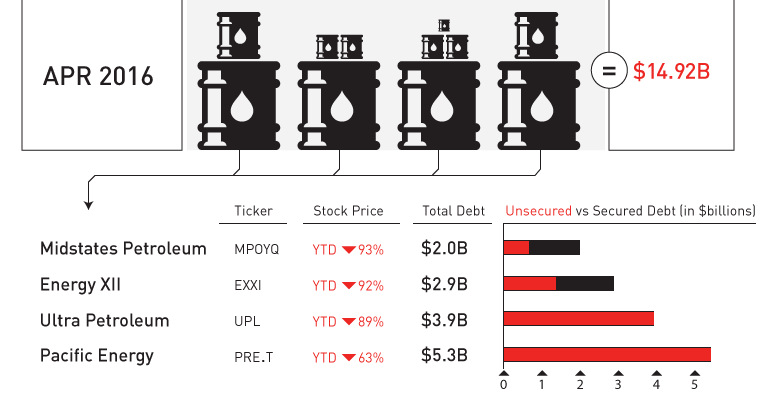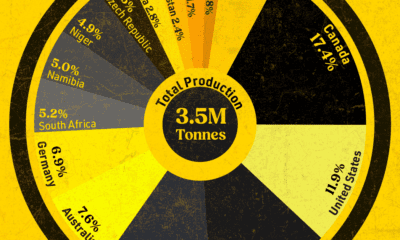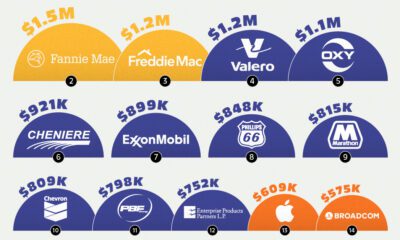Energy
Bankruptcy Mayhem in the Oil Patch [Chart]
![Bankruptcy Mayhem in the Oil Patch [Chart]](https://www.visualcapitalist.com/wp-content/uploads/2016/05/oil-patch-bankruptcies-chart.png)
Bankruptcy Mayhem in the Oil Patch [Chart]
Total debt of newly bankrupted energy companies is soaring each month
The Chart of the Week is a weekly Visual Capitalist feature on Fridays.
Most investors are aware that there is significant carnage in the oil patch. Low energy prices caught overleveraged companies off guard, and it’s forced many of these companies to seek protection from their creditors through bankruptcy.
However, the pace of new bankruptcies is accelerating fast, and now bigger companies are being affected. This week’s chart shows that the 11 new bankruptcies in April 2016 carry a substantial debt load of nearly $15 billion – most of which is unsecured.
A quick look at the data, which we pulled from Haynes and Boone, LLP, tells the tale:
| New Bankruptcies | Total Debt | Avg. Debt Per Company | |
|---|---|---|---|
| January 2016 | 3 | $32,000,000 | $10,666,667 |
| February 2016 | 6 | $280,000,000 | $46,666,667 |
| March 2016 | 7 | $1,840,000,000 | $262,857,143 |
| April 2016 | 11 | $14,920,000,000 | $1,356,363,636 |
In the first two months of 2016, there were nine bankruptcies. Not one of the companies filing had debts that exceeded $200 million.
In March, there were a total of seven new bankruptcies, including Venoco Inc. Venoco is a private company that is heavily oil-weighted with assets located offshore and onshore in Southern California. Venoco’s filing listed that it had $1.28 billion in debts, 71% of which are unsecured.
Meanwhile, April was the biggest month for oil patch bankruptcies in the last two years. A total of 11 companies filed, but even more meaningful to investors is that four of the bankruptcies were public companies with debts exceeding $1 billion.
Pacific Energy, formerly Pacific Rubiales, used to be the largest operating oil company in South America. Now, however, the company is in the midst of undergoing dramatic restructuring. Common shares have been delisted and the company is also seeking to get extensions on its $5 billion of unsecured debt.
Texas-based Ultra Petroleum, which has nearly $4 billion in unsecured debt, has dropped from the NYSE to the OTC as it too seeks protection. The stock’s 52 week high was $17, but it now shares are trading for mere pennies.
Two other big companies to go to court were Energy XII and Midstates Petroleum. They each owe roughly $3 billion and $2 billion of total debt, respectively. Energy XII operates 10 of the largest oilfields on the Gulf of Mexico Shelf, while Oklahoma-based Midstates is focused on the application of modern drilling and completion techniques in oil and liquids-rich basins in the onshore U.S.
The grand total of debt for all April bankruptcy filers was an astounding $14.9 billion, most of which is unsecured. For reference, the 42 energy companies that filed for bankruptcy in all of 2015 had a combined $17.2 billion in debt.
Energy
Charted: 4 Reasons Why Lithium Could Be the Next Gold Rush
Visual Capitalist has partnered with EnergyX to show why drops in prices and growing demand may make now the right time to invest in lithium.

4 Reasons Why You Should Invest in Lithium
Lithium’s importance in powering EVs makes it a linchpin of the clean energy transition and one of the world’s most precious minerals.
In this graphic, Visual Capitalist partnered with EnergyX to explore why now may be the time to invest in lithium.
1. Lithium Prices Have Dropped
One of the most critical aspects of evaluating an investment is ensuring that the asset’s value is higher than its price would indicate. Lithium is integral to powering EVs, and, prices have fallen fast over the last year:
| Date | LiOH·H₂O* | Li₂CO₃** |
|---|---|---|
| Feb 2023 | $76 | $71 |
| March 2023 | $71 | $61 |
| Apr 2023 | $43 | $33 |
| May 2023 | $43 | $33 |
| June 2023 | $47 | $45 |
| July 2023 | $44 | $40 |
| Aug 2023 | $35 | $35 |
| Sept 2023 | $28 | $27 |
| Oct 2023 | $24 | $23 |
| Nov 2023 | $21 | $21 |
| Dec 2023 | $17 | $16 |
| Jan 2024 | $14 | $15 |
| Feb 2024 | $13 | $14 |
Note: Monthly spot prices were taken as close to the 14th of each month as possible.
*Lithium hydroxide monohydrate MB-LI-0033
**Lithium carbonate MB-LI-0029
2. Lithium-Ion Battery Prices Are Also Falling
The drop in lithium prices is just one reason to invest in the metal. Increasing economies of scale, coupled with low commodity prices, have caused the cost of lithium-ion batteries to drop significantly as well.
In fact, BNEF reports that between 2013 and 2023, the price of a Li-ion battery dropped by 82%.
| Year | Price per KWh |
|---|---|
| 2023 | $139 |
| 2022 | $161 |
| 2021 | $150 |
| 2020 | $160 |
| 2019 | $183 |
| 2018 | $211 |
| 2017 | $258 |
| 2016 | $345 |
| 2015 | $448 |
| 2014 | $692 |
| 2013 | $780 |

3. EV Adoption is Sustainable
One of the best reasons to invest in lithium is that EVs, one of the main drivers behind the demand for lithium, have reached a price point similar to that of traditional vehicle.
According to the Kelly Blue Book, Tesla’s average transaction price dropped by 25% between 2022 and 2023, bringing it in line with many other major manufacturers and showing that EVs are a realistic transport option from a consumer price perspective.
| Manufacturer | September 2022 | September 2023 |
|---|---|---|
| BMW | $69,000 | $72,000 |
| Ford | $54,000 | $56,000 |
| Volkswagon | $54,000 | $56,000 |
| General Motors | $52,000 | $53,000 |
| Tesla | $68,000 | $51,000 |
4. Electricity Demand in Transport is Growing
As EVs become an accessible transport option, there’s an investment opportunity in lithium. But possibly the best reason to invest in lithium is that the IEA reports global demand for the electricity in transport could grow dramatically by 2030:
| Transport Type | 2022 | 2025 | 2030 |
|---|---|---|---|
| Buses 🚌 | 23,000 GWh | 50,000 GWh | 130,000 GWh |
| Cars 🚙 | 65,000 GWh | 200,000 GWh | 570,000 GWh |
| Trucks 🛻 | 4,000 GWh | 15,000 GWh | 94,000 GWh |
| Vans 🚐 | 6,000 GWh | 16,000 GWh | 72,000 GWh |
The Lithium Investment Opportunity
Lithium presents a potentially classic investment opportunity. Lithium and battery prices have dropped significantly, and recently, EVs have reached a price point similar to other vehicles. By 2030, the demand for clean energy, especially in transport, will grow dramatically.
With prices dropping and demand skyrocketing, now is the time to invest in lithium.
EnergyX is poised to exploit lithium demand with cutting-edge lithium extraction technology capable of extracting 300% more lithium than current processes.

-

 Lithium6 days ago
Lithium6 days agoRanked: The Top 10 EV Battery Manufacturers in 2023
Asia dominates this ranking of the world’s largest EV battery manufacturers in 2023.
-

 Energy2 weeks ago
Energy2 weeks agoThe World’s Biggest Nuclear Energy Producers
China has grown its nuclear capacity over the last decade, now ranking second on the list of top nuclear energy producers.
-

 Energy1 month ago
Energy1 month agoThe World’s Biggest Oil Producers in 2023
Just three countries accounted for 40% of global oil production last year.
-

 Energy1 month ago
Energy1 month agoHow Much Does the U.S. Depend on Russian Uranium?
Currently, Russia is the largest foreign supplier of nuclear power fuel to the U.S.
-

 Uranium2 months ago
Uranium2 months agoCharted: Global Uranium Reserves, by Country
We visualize the distribution of the world’s uranium reserves by country, with 3 countries accounting for more than half of total reserves.
-

 Energy3 months ago
Energy3 months agoVisualizing the Rise of the U.S. as Top Crude Oil Producer
Over the last decade, the United States has established itself as the world’s top producer of crude oil, surpassing Saudi Arabia and Russia.
-

 Science1 week ago
Science1 week agoVisualizing the Average Lifespans of Mammals
-

 Demographics2 weeks ago
Demographics2 weeks agoThe Smallest Gender Wage Gaps in OECD Countries
-

 United States2 weeks ago
United States2 weeks agoWhere U.S. Inflation Hit the Hardest in March 2024
-

 Green2 weeks ago
Green2 weeks agoTop Countries By Forest Growth Since 2001
-

 United States2 weeks ago
United States2 weeks agoRanked: The Largest U.S. Corporations by Number of Employees
-

 Maps2 weeks ago
Maps2 weeks agoThe Largest Earthquakes in the New York Area (1970-2024)
-

 Green2 weeks ago
Green2 weeks agoRanked: The Countries With the Most Air Pollution in 2023
-

 Green2 weeks ago
Green2 weeks agoRanking the Top 15 Countries by Carbon Tax Revenue











